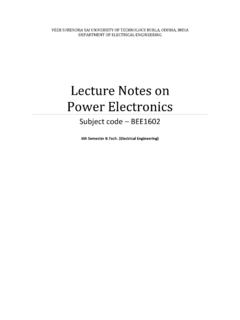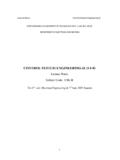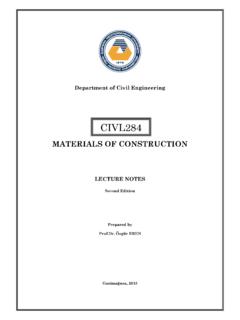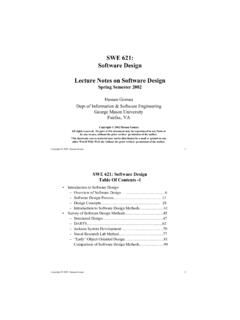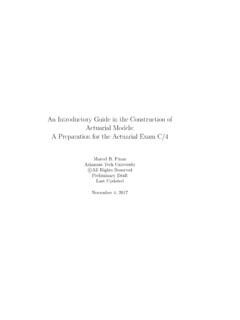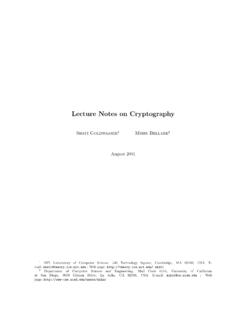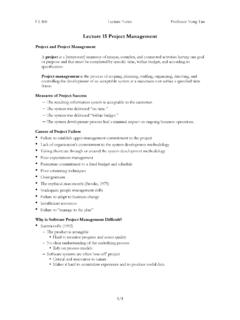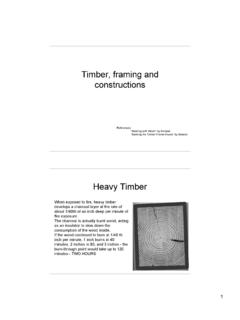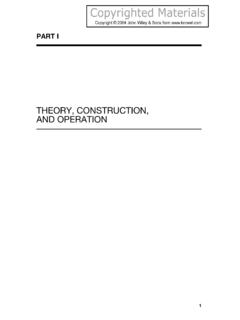Transcription of on CIVIL ENGINEERING MATERIALS & CONSTRUCTION …
1 lecture NOTE on CIVIL ENGINEERING MATERIALS & CONSTRUCTION course code : BCE 203 SYLLABUS Module Number Chapter Number Title lecture hours (3- 1- 0) 1 1 Brick 3 2 Cement 4 3 Concrete 3 Total 10 2 4 Arches 3 5 Cavity Wall 2 6 Stairs 3 Total 8 3 7 Fire Resistive CONSTRUCTION 2 8 Plastering 2 9 Damp prevention 2 Total 6 4 10 Types of doors and windows 3 11 Painting and decoration 2 12 Glazing 2 13 Repair of Building 2 14 Stone 1 15 Timber 4 16 Foundation 2 Total 16 Total lecture hours 40 Text books 1. A Text book of Building CONSTRUCTION , Arora and Bindra, Dhanpat Rai & Sons. Reference books 1 A Text Book of Building MATERIALS , Kulkarrni 2 Building MATERIALS , P. C. Varghese, PHI, Pvt. Ltd. 3 Building CONSTRUCTION , P. C. Varghese, PHI, Pvt. Ltd. 1. BRICK Constituents of good brick earth: Bricks are the most commonly used CONSTRUCTION material . Bricks are prepared by moulding clay in rectangular blocks of uniform size and then drying and burning these blocks.
2 In order to get a good quality brick, the brick earth should contain the following constituents. o Silica o Alumina o Lime o Iron oxide o Magnesia Silica o Brick earth should contain about 50 to % of silica. o It is responsible for preventing cracking, shrinking and warping of raw bricks. o It also affects the durability of bricks. o If present in excess, then it destroys the cohesion between particles and the brick becomes brittle. Alumina o Good brick earth should contain about 20% to 30% of alumina. o It is responsible for plasticity characteristic of earth, which is important in moulding operation. o If present in excess, then the raw brick shrink and warp during drying. Lime o The percentage of lime should be in the range of 5% to 10% in a good brick earth. o It prevents shrinkage of bricks on drying. o It causes silica in clay to melt on burning and thus helps to bind it. o Excess of lime causes the brick to melt and brick looses its shape. Iron oxide o A good brick earth should contain about 5% to 7% of iron oxide.
3 O It gives red colour to the bricks. o It improves impermeability and durability. o It gives strength and hardness. o If present in excess, then the colour of brick becomes dark blue or blakish. o If the quantity of iron oxide is comparatively less, the brick becomes yellowish in colour. 1* Under revisionMagnesia o Good brick earth should contain less a small quantity of magnesia about1%) o Magnesium in brick earth imparts yellow tint to the brick. o It is responsible for reducing shrinkage o Excess of magnesia leads to the decay of bricks. Harmful Ingredients in Brick: Below mentioned are some of the ingredients which are undesired in brick earth. Lime o A small quantity of lime is required in brick earth. But if present in excess, it causes the brick to melt and hence brick looses its shape. o If lime is present in the form of lumps, then it is converted into quick lime after burning. This quick lime slakes and expands in presence of moisture, causing splitting of bricks into pieces.
4 Iron pyrites o The presence of iron pyrites in brick earth causes the brick to get crystallized and disintegrated during burning, because of the oxidation of the iron pyrits. o Pyrites discolourise the bricks. Alkalis o These are exist in the brick earth in the form of soda and potash. It acts as a flux in the kiln during burning and it causes bricks to fuse, twist and warp. Because of this, bricks are melted and they loose their shape. o The alkalis remaining in bricks will absorb moisture from the atmosphere, when bricks are used in masonry. With the passage of time, the moisture gets evaporated leaving grey or white deposits on the wall surface (known asefflorescence). This white patch affects the appearance of the building structure. Pebbles o Pebbles in brick earth create problem during mixing operation of earth. It prevents uniform and through mixing of clay, which results in weak and porous bricks o Bricks containing pebbles will not break into shapes as per requirements.
5 Vegetation and Organic Matter o The presence of vegetation and organic matter in brick earth assists in burning. But if such matter is not completely burnt, the bricks become porous. This is due to the fact that the gasses will be evolved during the burning of the carbonaceous matter and it will result in the formation of small pores. 2* Under revision Efflorescence in BrickStone in Brick Manufacturing of bricks In the process of manufacturing bricks, the following distinct operations are involved. Preparation of clay Moulding Drying Burning Each of the above operation of the manufacturing bricks will now be studied at length. Preparation of clay The clay for brick is prepared in the following order. Unsoiling Digging Cleaning Weathering Blending Tempering Unsoiling: The top layer of the soil, about 200mm in depth, is taken out and thrown away. The clay in top soil is full of impurities and hence it is to be rejected for the purpose of preparing bricks.
6 Digging: The clay is then dug out from the ground. It is spread on the levelled ground, just a little deeper than the general level. The height of heaps of clay is about 600mm to 1200mm. Cleaning: The clay as obtained in the process of digging should be cleaned of stones, pebbles, vegetable matters. If these particles are in excess, the clay is to be washed and screened. Such a process naturally will prove to be troublesome and expensive. 3* Under revisionWeathering: The clay is then exposed to atmosphere for softening and mellowing. The period varies from few weeks to full season. Blending: The clay is made loose and any ingredient to be added to it , is spread out at its top. The blending indicates intimate or harmonious mixing. It is carried out by taking a small amount of clay every time and turning it up and down in vertical direction. The blending makes clay fit for the next stage of tempering. Tempering: In the process of tempering, the clay is brought to a proper degree of hardness and it is made fit for the next operation of moulding.
7 Kneaded or pressed under the feet of man or cattle .The tempering should be done exhaustively to obtain homogeneous mass of clay of uniform manufacturing good bricks on a large scale, tempering is done in pug typical pug mill capable of tempering sufficient earth for a daily output of about 15000 to20000 bricks. A pug mill consists of a conical iron tub with cover at its top .It is fixed on a timber base which is made by fixing two wooden planks at right angle to each other. The bottom of tub is covered except for the hole to take out pugged earth. The diameter of pug mill at bottom is about 800mm and that at top is about 1 provision is made in top cover to place clay inside pug mill .A vertical shaft with horizontal arms is provided at center of iron small wedge-shaped knives of steel are fixed at long arms are fixed at vertical shaft to attach a pair of bullocks.
8 The ramp is provided to collect the pugged clay .The height of pug mill is about 2m. Its depth below ground is 600m to800mm lessen the rise of the barrow run and to throw out the tempered clay the beginning, the hole for pugged clay is closed and clay with water is placed in pug mill from the top. When vertical shaft is rotated by a pair of bullock, the clay is thoroughly mixed up by the action of horizontal arms and knives and homogeneous mass is formed. The rotation of vertical shaft can also be achieved by using steam, diesel or electrical clay has been sufficiently pugged, the hole at the bottom of the tub, is opened out and pugged earth is taken out from the ramp by barrow a small cart with wheels for next operation of pug mill is then kept moving and feeding of clay from top and taking out of pugged clay from bottom are done tempering is properly carried out, the good brick earth can then be rolled without breaking in small threads of 3mm diameter.
9 4* Under revision Fig of a Pug mill Moulding: The clay which is prepared as above is then sent for the text operation of are two types of moulding: i. Hand Moulding ii. Machine Moulding Hand moulding: In hand moulding , the bricks are moulded by hand ; manually. I t is adopted where manpower is cheap and is readily available for the manufacturing process of bricks ona small moulds are rectangular boxes which are open at top and may be of wood or should be beprepared from well-seasonedwood. The longer sides are kept slightly projecting to serve as handles. The strips of brass or steel are sometimes fixed on the edges of wooden moulds to make them more is prepared from the combination of steel plate and channel. It may even be prepared from steel angles and plates. Thethickness of steel mould is is used for manufacturing bricks on alarge scale. The steel moulds are more durable than wooden one and turn out bricks of uniform bricks shrink during drying and burning.
10 Hence the mouldsare therefore made larger than burnt bricks (8-12%). The bricks prepared by hand moulding are of two types: Ground mouldedand Tablemoulded Ground mouldedbricks: The ground is first made level and fine sand is sprinkled over mould is dipped in water and placed over the ground. The lump of tempered clay is taken and is dashed is the clay is pressed in the mould in such a way that it fills all the corners of surplus clay is removed by wooden strike or framed with wire. A strike is a piece of wood or metal with a sharp is to be dipped in water every mould is then lifted up and raw brick ids left on the mould is dipped in water and it is placed just near the previous brick to prepare another process is repeated till the ground is covered with raw lower faces of ground moulded bricks are rough 5* Under revisionand it is not possible to place frog on such frog is mark of depth about 10mm to 20mm which is placed on raw brick during serves two purposes.




